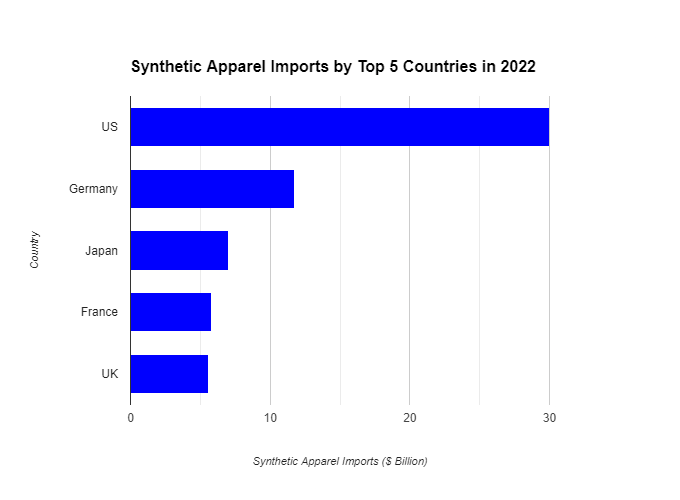Global trends in apparel imports shows a sharp increase in synthetic fabrics

Synthetic fabrics are dominating the global apparel market today. A recent study revealed the top five apparel importing countries – the US, Germany, Japan, France, and the UK – import almost 70 per cent synthetic garments and only 30 per cent natural fabric apparel.
This shift towards synthetic fabrics is due to a multitude of reasons, like technological advancements, changing consumer preferences, and economic considerations. Synthetic fibers offer a range of benefits such as durability, moisture-wicking properties, and affordability, making them attractive to both manufacturers and consumers.
Dominance of synthetic imports
A look at the table below shows, all five countries show a strong preference for synthetic apparel, with imports consistently exceeding 70 per cent of the total apparel imports. The US emerged largest importer of both total apparel and synthetic apparel, underscoring its significant role in the global fashion market. The high percentage of synthetic imports across all five countries suggests a global shift towards synthetic fibers in the apparel industry.
Table: Synthetic imports by top five countries in 2022
|
Country |
Total Apparel Imports ($ bn) |
Synthetic Apparel Imports ($ bn) |
Percentage of Synthetic Imports |
|
US |
42.27 |
29.97 |
71% |
|
Germany |
16.7 |
11.73 |
70% |
|
Japan |
10 |
7 |
70% |
|
France |
8.3 |
5.81 |
70% |
|
UK |
8 |
5.6 |
70% |
Source: Observatory of Economic Complexity (OEC)
So what’s driving this shift towards synthetic? One major factor is it performance and functionality. Modern textile technologies have enabled the production of high-performance synthetic fibers with enhanced properties like durability, moisture-wicking, and wrinkle resistance. This makes them ideal for athletic wear, outdoor clothing, and other performance-oriented garments.
In fact, the growing popularity of athleisure has pushed up demand for synthetic fabrics. Athleisure garments, designed for both athletic and casual wear, often incorporate synthetic fibers like polyester and spandex to provide comfort, flexibility, and moisture-wicking properties. This trend has significantly impacted the apparel industry, driving the demand for synthetic fabrics and reshaping consumer preferences.
Moreover they are a cost-effective option. Synthetic fibers are generally more affordable to produce than natural fibers, making them a cheaper option for both manufacturers and consumers. Synthetic fabrics have also become popular in fashion trends, particularly in fast fashion and sportswear. They offer a wide range of colors, textures, and finishes, allowing for creative and innovative designs.
However, the dominance of synthetic apparel in the global market raises concerns about environmental sustainability. Synthetic fibers, particularly those derived from petroleum, have a significant environmental footprint, contributing to pollution and waste. As consumers become more environmentally conscious, the industry may need to shift towards more sustainable practices, such as using recycled synthetic fibers and promoting eco-friendly production methods.
Indeed, as demand for synthetic apparel continues to grow, it is essential to address the environmental implications associated with their production and disposal. Sustainable practices, such as recycling and upcycling, can help mitigate the negative impact of synthetic fibers. Additionally, innovation in materials science may lead to the development of more eco-friendly synthetic alternatives.
